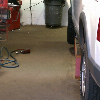2000StreetRod
Moderator Emeritus
- Joined
- May 26, 2009
- Messages
- 10,597
- Reaction score
- 334
- City, State
- Greenville, SC
- Year, Model & Trim Level
- 00 Sport FI, 03 Ltd V8
Possible thermostat location
The marked up old photo below indicates a possible location (brown rectangle) for an engine oil cooler thermostat. The full flow remote filter will have to be moved (green arrows) to make room for the thermostat. There will not be much room for the cooler to thermostat connections. A little more room (.5 to .75 inch) can be achieved by moving the cooler toward the A/C condenser support bracket.

The black lines around the center filter indicate the larger size of the Amsoil bypass filter.
While waiting to find a suitable oil thermostat I'll reroute the ATF and engine oil hoses to utilize the radiator oil cooler to cool the ATF. That probably can be done without any new parts. I won't move the full flow filter mount or the engine oil cooler until I have a thermostat and determine what fittings/hoses are needed.
The marked up old photo below indicates a possible location (brown rectangle) for an engine oil cooler thermostat. The full flow remote filter will have to be moved (green arrows) to make room for the thermostat. There will not be much room for the cooler to thermostat connections. A little more room (.5 to .75 inch) can be achieved by moving the cooler toward the A/C condenser support bracket.
The black lines around the center filter indicate the larger size of the Amsoil bypass filter.
While waiting to find a suitable oil thermostat I'll reroute the ATF and engine oil hoses to utilize the radiator oil cooler to cool the ATF. That probably can be done without any new parts. I won't move the full flow filter mount or the engine oil cooler until I have a thermostat and determine what fittings/hoses are needed.











